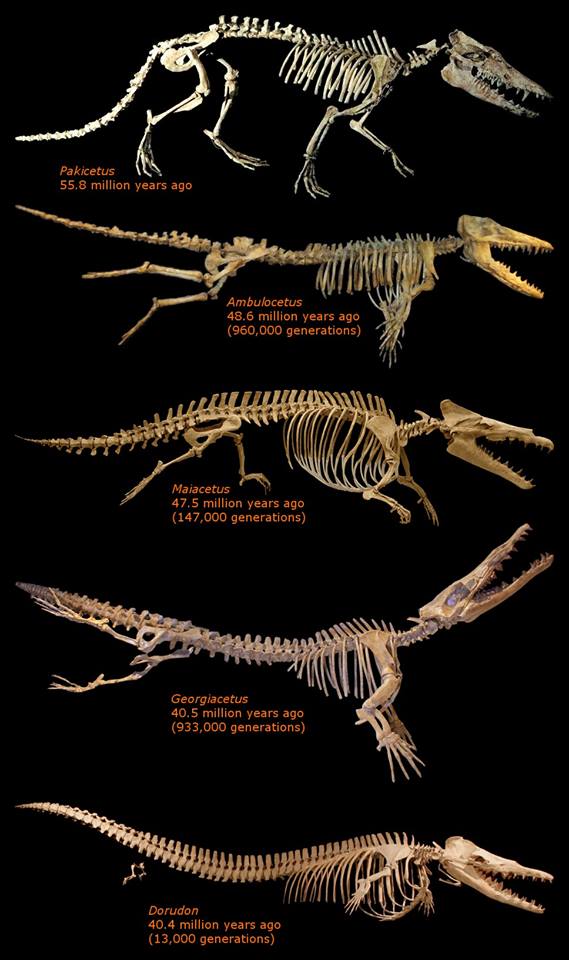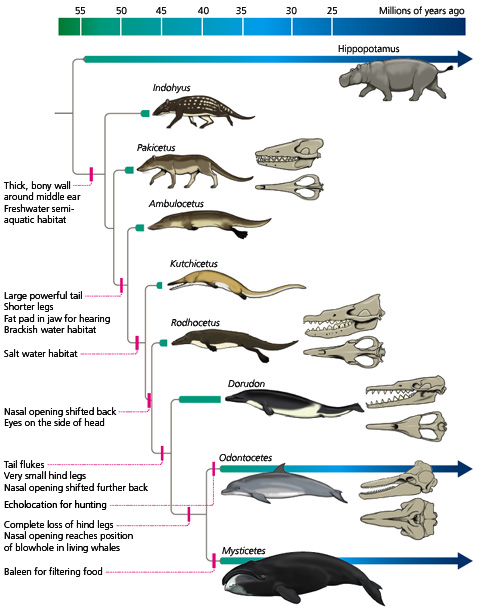I am not sure what you intended to prove by posting all of those charts, but let me comment on this one:
Packicetus: no blowhole, no flippers, no whale type of neck, no whale-like ear bone, and no other whale features. It is a typical land animal.
Ambulocetus: no whale-like ear bone (as claimed), no blowhole, and no other whale features.
Rodhocetus: newer fossil evidence revealed there is no evidence of a whale-like tail or flippers, as originally claimed.
Therefore, you can strike those three out of the chart.
To play it safe, it would also be a good idea to strike out any others that Gingerich, his students, or colleagues claim to be whale transition forms
Dan
Pakicetus of course it has no blow hole, its at the beginning of the succession while the ancestors still lived on land. It has a rounded whale like skull, angular teeth, and its in the right location at the right time, as we will see with further fossils.
Ambulocetus: no other whale features? it has its triangular ungulate teeth like those of whales, it has a long snout like pakicetus and rodhocetus, it was a marine animal, it has an undulating spike with shorter limbs. Just like pakicetus, it has aquatic traits, while still clearly has terrestrial features indicating that it is not a whale.
Ill add two more here, Dalanistes and remingtonocetus: longer whale like snout, contain the same whale like teeth, webbed feet, yet still with terrestrial traits, like toes.
"
The vertebral elements of the sacrum are solidly fused and form a well-developed articular surface for the pelvis.
The ilium is robust and long, and has a large acetabulum similar to that in
Remingtonocetus. The femur had a
spherical head, a medial condyle considerably larger than the lateral, and a shallow patellar groove. Taken together this morphology suggests the presence of well-developed hind limbs.
[2]
Dalanistes is similar to but 20% larger than
Remingtonocetus; the
external nares are located more anteriorly (above C1); the
sagittal crestis much higher; the rostrum is angled down 20° relative to the main axis of the braincase; the mandibular symphysis is relatively open (ends at P3) and the mandibular canals fail to unite at the symphysis. This mandibular morphology is also different from that of
Andrewsiphius (another remingtonocetid).
[4]"
"
Remingtonocetus is larger, has a
broader rostrum, and longer
premolars than
Andrewsiphius. It is smaller than, has more gracile premolars and molars than
Dalanistes.
R. harudiensis differs from
R. domandaensis in molar morphology.
[4]
Gingerich et al. 2001 interpreted
R. domandaensis as an older and more generalized species than
R. harudiensis. Based on a morphological analysis,
they concluded that the hindlimbs of Remingtonocetus were probably not weight-bearing, and that (1) the fused sacrum indicates a limitation in
tail-powered locomotion, and (2) the presence of powerful hip extensors and femoral adductors indicates that
Remingtonocetus was an efficient and specialized
foot-powered swimmer.[5]
Remingtonocetus had four working and usable limbs,
a slender whale-like body with long tail and slender, hydrodynamic head."
So what we see are animals of a succession with increasingly more and more whale like features. Although they are not whales themselves, and therefore do not have things like blow holes.
Rodhocetus: Rodhocetus has a further elongated snout. Its similar to ambulocetus and pakicetus, but it has not only a longer whale like snout, but also shorter limbs
Rodhocetus spp. | College of Osteopathic Medicine | NYIT
"Additionally, the vertebrae of the sacrum (
the portion of the vertebral column that is connected to the pelvis) are not fused together, unlike is the condition seen in all land mammals. The unfused sacrum allows the vertebral column to be more flexible during swimming, at the expense of better support of the body on land."
"The vertebrae of the upper back have very tall spines like those of some land mammals, again suggesting that this whale may have been able to support its weight on land. Small bony crests on the toe bones imply that
Rodhocetus had webbed feet (an obvious adaptation for swimming), but the toes themselves appear to have been hoof-shaped.
The fore- and hindlimbs of Rodhocetus are relatively short as compared to those of most land mammals, particularly those adapted for running. "
"
Sensory Abilities: Although the skull of
Rodhocetus is fairly complete, few details have been published on its skull and ear region.
The lower jaw has a large hole near the jaw joint (the mandibular foramen), which in modern toothed whales, is filled with fat ("the mandibular fat pad"). In living odontocetes, sound travels through the thin bone on the side of the jaw and is channeled into the middle and inner ear by the pad of fat. In land mammals (including humans), underwater hearing takes place by sound waves traveling through the bones of the skull to the ears. Sound traveling in this manner arrives at each ear at nearly the same time, and it is not possible to tell the direction from which the sound came.
The fat pad in the lower jaw of Rodhocetus and some other cetaceans allows directional hearing when underwater. This indicates that Rodhocetus was well adapted to the aquatic environment."
---------------------------------------------------------------------------------
The point is that, none of these animals are actually whales, but what we see are land animals becoming more and more, progressively like whales. and they are very similar to one another, though we see shortening limbs, an elongation of the snout, and more and more progressively aquatic features forming, one after another.
Also, theyre found in the same region. Pakicetus and land based ancestors are found in shallow marine and terrestrial environments, while further down the list when we get to rodhocetus, we are in marine environments. But theyre regionally in the same place. Its not like anyone went out and picked up one in america and the other in china. They are in a geologic succession, from deep layers to shallow, grading from more land like to more sea like.[/QUOTE]
Ill add another.
Basilosaurus: Longer body, longer snout, same whale like skull, same whale like teeth, aquatic
The snout progressing toward the back of the skull.
Its about mid-way now. Unfused hips, but still that same iconic long snout with whale like teeth. Still not a true blow hole though. But it does appear to be a whale, just not like any whale we have seen before..
I can keep going...










